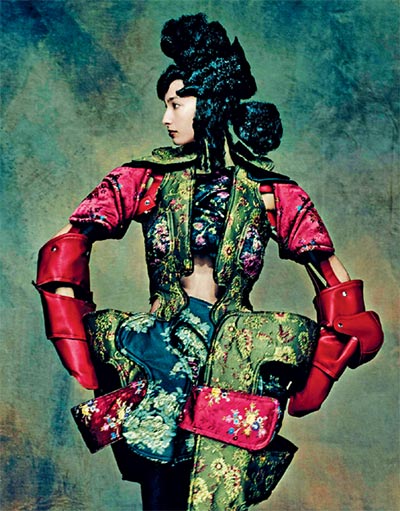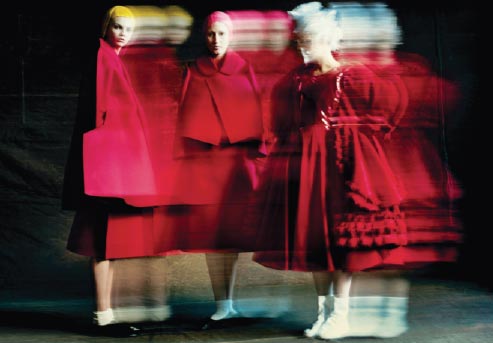
Between worlds
Sonia Altshuler
Japanese designer Rei Kawakubo's singular view of fashion is finally getting the mass recognition it so richly deserves.

Rei Kawakubo clearly isn't Miuccia Prada, but in the countercultural ecosystem of fashion for the disenfranchised, the two bear remarkable similarities. Geography has seemingly dictated the impact of both.
Prada has been subject to an A to Z of academic rigor across the fashion campuses of Europe and America, and she been the subject of a Metropolitan Museum exhibition herself in tandem with Elsa Schiaparelli.
But Kawakubo, the creator of Tokyo-based Comme des Garçons ("like boys"), which has grown into a business that churns more than $220 million a year, has remained largely the preserve of the Japanese. She's also the co-founder of London's hip Dover Street Market fashion destination, which she founded in 2004 with her husband, Adrian Joffe.
Now, it seems Kawakubo's global moment is at hand as she gets a five-month-long run at the Metropolitan Museum of Art's Costume Institute in New York with Art of the In-Between, running until September. It's the first monographic exhibition of a living designer at the Met since the Yves Saint Laurent show in 1983.
Prada basically epitomizes "ugly chic" in the world today, through her use of fabrics that challenged notions of luxury coupled with provocative designs, but Kawakubo was doing the same several years earlier (at least as far as the West was concerned) when she made her Paris debut in 1981. Kawakubo's early collections established an unsettling zone of ambiguity that challenged the accepted notions of beauty, good taste, and even fashionability.
One of the first designers to truly challenge the notions of classic tailoring, Kawakubo's cri de coeur has become deconstruction, bias cuts and all sorts of experiments in shape, seams and asymmetry-much of it gender-bending, such as men's buttoning on an assortment of women's garments. "Since her Paris debut in 1981, Rei has consistently defined and redefined the aesthetics of our time," remarked Andrew Bolton, curator of the Kawakubo exhibition at the Met, at a press conference to announce the upcoming show. "Season after season, she changes our eye by upending the received notions of conventional beauty and by disrupting the defining characteristics of the fashionable body."
For Kawakubo, clothes seem to be her mode of expression on an endless search for newness and originality. Speaking about her spring/summer 2014 collection, she said in a 2013 interview with System magazine: "I tried to look at everything I look at in a different way. I thought a way to do this was to start out with the intention of not even trying to make clothes. I tried to think and feel and see as if I wasn't making clothes."
Kawakubo didn't study fashion, but art and literature, at Keio University. Her first job was at a textiles factory in 1967, which led to her becoming a freelance stylist. Two years later, Comme des Garçons was born, but it wasn't until 1975 that she opened her first store in Tokyo, by which time the Japanese press referred to her tribal followers as "the crows". She soon inspired the likes of Martin Margiela, Ann Demeulemeester and Dries Van Noten, and helped launch the careers of Junya Watanabe, Tao Kurihara and Chisato Abe. But the fashion mainstream in the West never really got to know her. Many attribute Prada's success to Miuccia's ability to bridge the gap between antifashion and commercial high fashion.

Miuccia Prada is candid about Kawakubo's economically discreet impact on global fashion culture.
"I always say 'Thank God Rei doesn't want to be commercial'," Prada said in a 2016 interview with 10 Magazine. "Otherwise, we would all be dead."
It's precisely Kawakubo's market insensitive approach that defines her singularity. "If, as Andy Warhol proposed, 'Business art is the step after art,' Rei is its fashion manifestation," remarked Bolton. "It's within this elastic zone between fashion and commerce that Rei's 'art of the in-between' occupies and most powerfully expresses itself."
The closest Kawakubo ever came to outright commerciality was collaborating with Swedish retail giant H&M in 2008.
"I have always been interested, as an independent businesswoman, in the balance between creation, which is the core value of Comme des Garçons, and good business, which comes a close second," Kawakubo told this reporter that year. "Comme des Garçons with H&M is the epitome of this challenge."
Margareta van den Bosch, creative director at H&M (which is sponsoring the exhibition, along with Apple, Farfetch and Valentino) said that Kawakubo had been atop their wishlist for design collaborators from the start.
"She's always been at the forefront, experimenting with garments, never following any rules. We have tremendous respect for Kawakubo's fashion philosophy, which questions the entire fashion world's ingrained patterns."
One simple mantra may explain what has evolved: "It's easier to break the rules if you haven't learned them," Kawakubo told this reporter a decade ago. At the time of the collaboration with H&M, she was pre-empting millennial-speak: "There is more and more demand for independent points of view because not everyone wants to be the same as everyone else. Ultimately, people like to be free and independent, if given half the chance."
And in a world full of electronic excitation and daily digital onslaught, Kawakubo's retraction from culture is a plus. For someone so present in terms of influence, she's aesthetically and commercially absent. "Going around museums and galleries, seeing films, talking to people, seeing new shops, looking at silly magazines, taking an interest in the activities of people in the street, looking at art, traveling: all these things are not useful, all these things do not help me, do not give me any direct stimulation to help my search for something new. And neither does fashion history. The reason for that is that all these things above already exist," she said in the 2013 System interview. "I only can wait for the chance for something completely new to be born within myself."
Kawakubo makes for an inspiring figure and, for many, an epiphany.
"There is no right or wrong way," she said in an interview with this reporter. "Comme des Garçons is always looking for new ways to express its values, which are based around creating new ideas and making strong, creative clothes."
Visit the Met's Costume Institute and marvel at the below-theradar output of a woman whose work may be timeless, but whose moment of recognition-while more than welcome-is happening at least a decade too late.